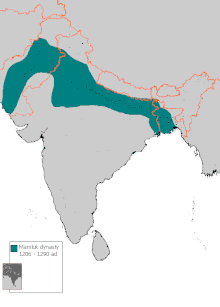Slave dynasty


The slave dynasty ( Persian سلطنت غلامان, DMG Salṭanat-i ġulāmān ) provided the first sultans of Delhi in India from 1206 to 1290. The founder of the dynasty, Qutb-ud-Din Aibak , was a former Turkish slave of the Aibak tribe who became the commander of the armies and administrator of the Rulership of Muhammad of Ghurs in India.
history
After the Ghuride Muizz ad-Din Muhammad died in 1206 without an heir, Qutb-ud-Din fended off all rivals who wanted to gain possession of Muhammad's Indian Empire. He established his capital first in Lahore and later in Delhi , where he began building the Qutb complex .
Qutb-ud-Din had a fatal accident in a polo game in 1210 and Iltutmish , another former Turkish slave, emerged victorious from the succession battle . Sultan Iltutmish extended the Sultanate's territory to the Sindh during his 25-year rule and brought renegade Bengal under his control; he married Qutb-ud-Din's daughter, and all but one of the later sultans of the dynasty were his descendants, including his daughter, Razia , who ruled for four years. Sultan Ghiyas ud din Balban was also a former slave who commanded the armies of Sultan Nasir ud din Mahmud, kept the Mongols in check and eventually took the throne himself. After brief reigns from Balban's grandchildren and great-grandchildren, the slave dynasty of Jalal ud din Firoz Khalji was overthrown from the Khalji dynasty , which had already distinguished itself in Bihar and Bengal during the reign of Muhammad Ghori.
Ruler
- Qutb-ud-Din Aibak (1206-1210)
- Aram Shah (1210-1211)
- Shams ud din Iltutmish (1211-1236). Son-in-law of Qutb-ud-din Aybak.
- Rukn ud din Firuz (1236). Son of Iltutmish.
- Raziyyat ud din Sultana (1236-1240). Daughter of Iltutmish.
- Muiz ud din Bahram (1240-1242). Son of Iltutmish.
- Ala ud din Masud (1242-1246). Son of Rukn ud din.
- Nasir ud din Mahmud (1246-1266). Son of Iltutmish.
- Ghiyas ud din Balban (1266-1286). Former slave, son-in-law of Iltutmish.
- Muiz ud din Qaiqabad (1286-1290). Grandsons of Balban and Nasir ud din.
- Kayumars (1290). Son of Muiz ud din.
See also
literature
- Hermann Kulke and Dietmar Rothermund : History of India. From the Indus culture to today. CH Beck, Munich 2010, ISBN 978-3-406-60414-0 .
Web links
- Slave Dynasty - Encyclopaedia Britannica (English)
- Slave Dynasty - Map + Info (English)
Individual evidence
- ↑ For the origin and distribution of the so-called "slave armies" in the Islamic world, see the article Knabenlese
